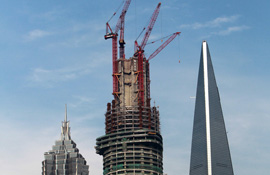|
 |
 |
|
RURAL LIFE: A family from Heming Village, Liujie Town in Chengdu, capital of southwest China's Sichuan Province (JIN LIANGKUAI) |
CHALLENGING THE SKY: The Shanghai Tower, which is currently under construction, reached 400 meters in height on December 14, 2012 (PEI XIN) |
"China, along with the United States, Europe, India and Japan, will become the five engines of world economic development, forging ahead side by side," said Justin Yifu Lin, a member of the National Committee of the Chinese People's Political Consultative Conference (CPPCC) and former Chief Economist of the World Bank. On more than one occasion he expressed confidence that China would likely outstrip the United States and Europe to become the world's largest market by 2030.
Although Lin's prediction is backed by other global economists, the "Coming Collapse of China" view has also been widely propagated across the world. Western media has even paralleled the hard landing of China's economy with the deteriorating eurozone debt crisis, aggravating U.S. debt problems, Middle East turmoil and Britain's withdrawal from the European Union as the five major threats to the world's economic recovery in 2013.
Will China become an engine for or a threat to the world economy? Things have never been more uncertain since the country began opening up to the outside world.
A rapid rise
In the past three decades with a market economy in place, China has registered an average growth rate of 9.8 percent, and is second to the United States in overall GDP.
As British economist Angus Maddison calculated, China's GDP accounted for 32.9 percent of the world total in 1820. Beginning in that century, however, China began to lag behind Western countries as the latter continued to industrialize. In 1978, China made up only 4.9 percent of the world's total GDP. But by 2010, China replaced Japan as the world's second largest economy and topped the world in exports.
Wu Jinglian, a renowned economist and a member of the CPPCC National Committee, believes credit should go to the entrepreneurship that followed the establishment of a market economy. When the new market system began to take shape, the long-repressed and huge potential for productivity was gradually liberalized, propelling China to achieve rapid economic growth.
Wu's view echoes that of Liang Xiaomin, a professor from Beijing Technology and Business University. Liang noted that the household contract responsibility system, which was carried out in rural areas when China began reform and opening up, laid a foundation for further reforms and economic development. The emerging of numerous private businesses has injected tremendous vigor into China's economy, contributing 60 percent to China's GDP.
Since entering the new century, the soaring economic strength has created a propitious environment for technological innovation, which has in turn added to the country's economic vitality. Moreover, attention has also been given to the improvement of the legal system, such as the promulgation of Property Law and Patent Law. For all these reasons, Liang also expressed strong confidence in China's economy.
Li Daokui, a professor from Tsinghua University and a member of the CPPCC National Committee, expressed a similar viewpoint. Li held that there were two major driving forces for further economic growth. One is the huge consumption potential of a large population, the other is the constant investment in infrastructure projects during the process of urbanization and changes in people's lifestyle.
Chinese features
With constant economic expansion, high GDP growth has become increasingly difficult to obtain. The lowest growth rate that China experienced since 1999 was 7.8 percent. In this sense, people tend to believe China will maintain a moderate growth rate ranging from 7 percent to 8 percent in the future.
Also on the minds of many is a dwindling demographic dividend. "Two factors put China's demographic dividend on the decline," said Liang. For one thing, GDP growth means higher living standards and higher wages. For another, as the generation born in the 1980s moves into the labor force, the family planning policy established in the 1970s has led to a labor shortage.
|
